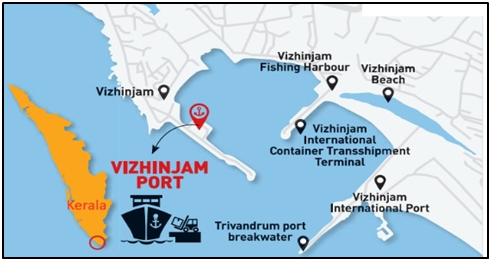Vizhinjam Port Project and its Significance
19-10-2023
01:45 PM

What’s in today’s article?
- What’s in today’s article?
- Why in news?
- Deepwater transshipment port
- Why India needs a container transshipment port?
- Vizhinjam International Seaport Project
- What are the features of the Vizhinjam port?
- Current status of the project

Why in news?
- Kerala Chief Minister flagged in the first-ever cargo ship at the under-construction Vizhinjam international seaport project, the country’s first deepwater transshipment port.
Deepwater transshipment port
- Deepwater port
- A deepwater port is a manmade structure that are used as ports or terminals to transport, store, or handle oil or natural gas.
- These structures can be fixed or floating, and are located beyond state seaward boundaries.
- They can include: Pipelines, Pumping stations, Service platforms, Mooring buoys.
- Transshipment port
- A transshipment port is a port where goods are offloaded and loaded onto a different ship to continue their journey to their final destination.
Why India needs a container transshipment port?
- Lacks infrastructure to deal with ultra-large container ships
- India has 13 major ports. However, the country lacks a landside mega-port and terminal infrastructure to deal with ultra-large container ships.
- Hence, nearly 75 per cent of India’s transshipment cargo is handled at ports outside India, mainly Colombo, Singapore, Dubai and Klang.
- In fiscal 2021-22, the total transshipment cargo of India was about 4.6 million TEUs (twenty-foot equivalent units), out of which about 4.2 million TEUs were handled outside India.
- Othe benefits
- Developing such ports will accrue significant benefits such as forex savings, foreign direct investment, increased economic activity at other Indian Ports.
- It will also lead to the development of related logistics infrastructure, employment generation, improved operation/logistics efficiencies and increase in revenue share.
- Several other allied businesses ship chandlery (ship supplies), ship repair, crew change facility, logistics value-added services, warehousing and bunkering also come up at the transshipment port.
- Increased economic activities
- A deepwater container transshipment port can attract a large share of the container transshipment traffic.
Vizhinjam International Seaport Project
- Located in Vizhinjam (near Thiruvananthapuram), Kerala, this transshipment deepwater multipurpose seaport project is being built by Adani Ports and SEZ Private Limited.
- It is being built on a design, build, finance, operate and transfer (DBFOT) model.
- DBFOT model is a Public-Private Partnership (PPP) model. In this model, a private partner is responsible for:
- Designing the project
- Building the project
- Financing the project
- Operating the project during the contracted period
- Transferring the project back to the public sector
- The DBFOT model is usually used for large-scale infrastructure projects.
- The private partner is granted a concession by the public sector to finance, design, construct, own, and operate the project for a period of 20 to 30 years.
- After that period, the project is returned to the public entity that originally granted the concession.
- DBFOT model is a Public-Private Partnership (PPP) model. In this model, a private partner is responsible for:
- According to the agreement, out of the total investment, Adani Group is supposed to invest Rs 2,454 crore and another Rs 1,635 crore will be mobilised from the state and central governments as viability gap funding.
- The Kerala government has given 500 acres of land.
- The DBFOT deal is for 40 years, with provisions extending for 20 years.
What are the features of the Vizhinjam port?
- India’s first international deepwater transshipment port
- It has a natural depth of more than 18 meters, scalable up to 20 meters.
- This depth is crucial to get large vessels and mother ships.
- It is designed to cater to container transshipment, multi-purpose and break-bulk cargo.
- The cost of movement of containers to and from foreign destinations is likely to come down.
- It has a natural depth of more than 18 meters, scalable up to 20 meters.
- Strategic location
- The port is located ten nautical miles from the international shipping route.
- The port is expected to compete with Colombo, Singapore, and Dubai for winning trans-shipment traffic.
- Increased capacity and minimum maintenance
- Its capacity in the first phase is one million TEU, which can be increased to 6.2 million TEU.
- Other features include minimal littoral drift along the coast and virtually no requirement for any maintenance dredging.
- Economic benefits
- The project is expected to generate 5,000 direct job opportunities, apart from giving a boost to an industrial corridor and cruise tourism.
- Vizhinjam port offers large-scale automation for quick turnaround of vessels with state-of-the-art infrastructure to handle Mega-max container ships.
Current status of the project
- As per the latest assessment, 65.46 per cent of the project is done.
- As per the latest work schedule, the first phase of the project is slated to be operational in December 2024.
- After inking the deal in 2015, the project was supposed to be made operational in 1,000 days. It had set a target to handle 20 million tons of cargo by 2020.
- The 2017 Ockhi cyclone, the Covid-19 pandemic, the acute shortage of granite boulders to build a 3.1-km breakwater and last year’s fishermen’s protest contributed to the delay.
Q1) What is build, finance, operate and transfer (DBFOT) model?
DBFOT model is a Public-Private Partnership (PPP) model. In this model, a private partner is responsible for: Designing the project, Building the project, Financing the project, Operating the project during the contracted period, Transferring the project back to the public sector. The DBFOT model is usually used for large-scale infrastructure projects.
Q2) What is Public-Private Partnership (PPP) model?
A public-private partnership (PPP) is a long-term agreement between a government and a private sector company. PPPs are used to finance, build, and operate public infrastructure projects and initiatives.
Source: CPM, Congress fight for credit over the Vizhinjam port: The project and its significance | US Maritime Administration | Frontline


